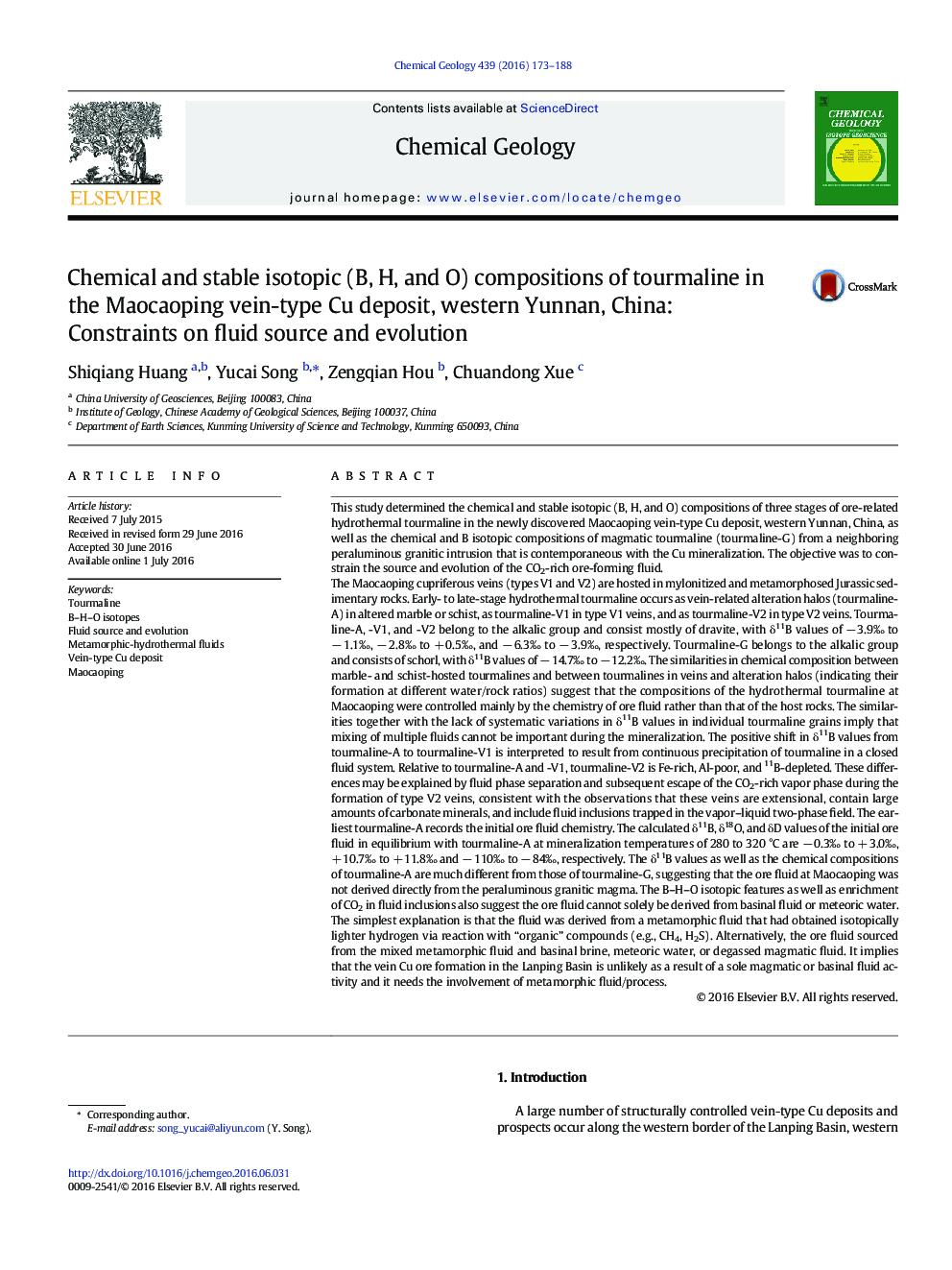| کد مقاله | کد نشریه | سال انتشار | مقاله انگلیسی | نسخه تمام متن |
|---|---|---|---|---|
| 4698265 | 1637535 | 2016 | 16 صفحه PDF | دانلود رایگان |

This study determined the chemical and stable isotopic (B, H, and O) compositions of three stages of ore-related hydrothermal tourmaline in the newly discovered Maocaoping vein-type Cu deposit, western Yunnan, China, as well as the chemical and B isotopic compositions of magmatic tourmaline (tourmaline-G) from a neighboring peraluminous granitic intrusion that is contemporaneous with the Cu mineralization. The objective was to constrain the source and evolution of the CO2-rich ore-forming fluid.The Maocaoping cupriferous veins (types V1 and V2) are hosted in mylonitized and metamorphosed Jurassic sedimentary rocks. Early- to late-stage hydrothermal tourmaline occurs as vein-related alteration halos (tourmaline-A) in altered marble or schist, as tourmaline-V1 in type V1 veins, and as tourmaline-V2 in type V2 veins. Tourmaline-A, -V1, and -V2 belong to the alkalic group and consist mostly of dravite, with δ11B values of − 3.9‰ to − 1.1‰, − 2.8‰ to + 0.5‰, and − 6.3‰ to − 3.9‰, respectively. Tourmaline-G belongs to the alkalic group and consists of schorl, with δ11B values of − 14.7‰ to − 12.2‰. The similarities in chemical composition between marble- and schist-hosted tourmalines and between tourmalines in veins and alteration halos (indicating their formation at different water/rock ratios) suggest that the compositions of the hydrothermal tourmaline at Maocaoping were controlled mainly by the chemistry of ore fluid rather than that of the host rocks. The similarities together with the lack of systematic variations in δ11B values in individual tourmaline grains imply that mixing of multiple fluids cannot be important during the mineralization. The positive shift in δ11B values from tourmaline-A to tourmaline-V1 is interpreted to result from continuous precipitation of tourmaline in a closed fluid system. Relative to tourmaline-A and -V1, tourmaline-V2 is Fe-rich, Al-poor, and 11B-depleted. These differences may be explained by fluid phase separation and subsequent escape of the CO2-rich vapor phase during the formation of type V2 veins, consistent with the observations that these veins are extensional, contain large amounts of carbonate minerals, and include fluid inclusions trapped in the vapor–liquid two-phase field. The earliest tourmaline-A records the initial ore fluid chemistry. The calculated δ11B, δ18O, and δD values of the initial ore fluid in equilibrium with tourmaline-A at mineralization temperatures of 280 to 320 °C are − 0.3‰ to + 3.0‰, + 10.7‰ to + 11.8‰ and − 110‰ to − 84‰, respectively. The δ11B values as well as the chemical compositions of tourmaline-A are much different from those of tourmaline-G, suggesting that the ore fluid at Maocaoping was not derived directly from the peraluminous granitic magma. The B–H–O isotopic features as well as enrichment of CO2 in fluid inclusions also suggest the ore fluid cannot solely be derived from basinal fluid or meteoric water. The simplest explanation is that the fluid was derived from a metamorphic fluid that had obtained isotopically lighter hydrogen via reaction with “organic” compounds (e.g., CH4, H2S). Alternatively, the ore fluid sourced from the mixed metamorphic fluid and basinal brine, meteoric water, or degassed magmatic fluid. It implies that the vein Cu ore formation in the Lanping Basin is unlikely as a result of a sole magmatic or basinal fluid activity and it needs the involvement of metamorphic fluid/process.
Journal: Chemical Geology - Volume 439, 7 November 2016, Pages 173–188